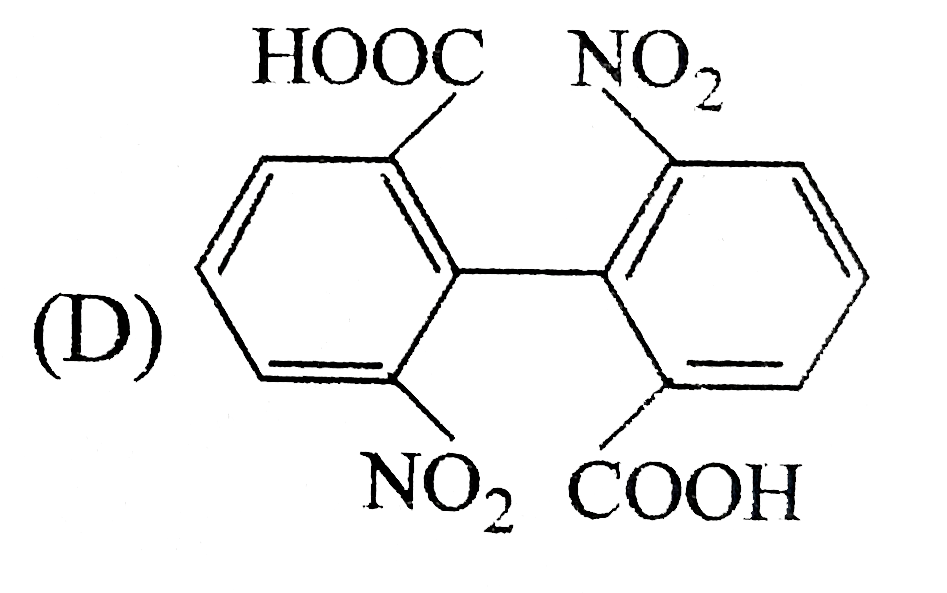Amongst the following compounds, the optically active alkane having lowest molecular mass is:
CH3−CH2−CH3

CH3−CH2−CH3∣CH−CH3
CH3−CH2−C≡C−H
The correct Answer is:B
To determine which of the given compounds is the optically active alkane with the lowest molecular mass, we will analyze each compound step by step.
Step 1: Identify the Compounds
Let's denote the compounds as A, B, C, and D for clarity. We need to check each compound for chirality and molecular mass.
Step 2: Analyze Compound A
- Structure: Compound A has two identical groups attached to a carbon atom.
- Chirality: Since it has two identical groups, it cannot be chiral (optically inactive).
- Conclusion: Compound A is not optically active.
Step 3: Analyze Compound B
- Structure: Compound B has a carbon atom bonded to four different groups: a cyclopentane ring, an ethyl group (C2H5), a methyl group (CH3), and a hydrogen atom (H).
- Chirality: Since all four groups attached to the chiral carbon are different, this compound is chiral and therefore optically active.
- Molecular Mass: Calculate the molecular mass of Compound B. (Assuming the molecular formula is CxHy, calculate based on the specific structure provided).
Step 4: Analyze Compound C
- Structure: Compound C has one hydrogen atom, two methyl groups (CH3), and one other group attached to a carbon atom.
- Chirality: Since there are two identical methyl groups, this compound cannot be chiral (optically inactive).
- Conclusion: Compound C is not optically active.
Step 5: Analyze Compound D
- Structure: Compound D has a carbon atom with a hydrogen atom, a methyl group (CH3), and a carbon chain with a triple bond.
- Chirality: The presence of identical groups (two CH3 groups) means it cannot be chiral.
- Conclusion: Compound D is not optically active.
Step 6: Compare Molecular Masses
- Now, we need to compare the molecular masses of the compounds we analyzed:
- Compound A: Not optically active.
- Compound B: Optically active (calculate its molar mass).
- Compound C: Not optically active.
- Compound D: Not optically active.
Final Conclusion
- The only optically active compound is Compound B, and it has the lowest molecular mass among the options provided.
Answer
The optically active alkane having the lowest molecular mass is Compound B.
---
Let's denote the compounds as A, B, C, and D for clarity. We need to check each compound for chirality and molecular mass.
- Structure: Compound A has two identical groups attached to a carbon atom.
- Chirality: Since it has two identical groups, it cannot be chiral (optically inactive).
- Conclusion: Compound A is not optically active.
- Structure: Compound B has a carbon atom bonded to four different groups: a cyclopentane ring, an ethyl group (C2H5), a methyl group (CH3), and a hydrogen atom (H).
- Chirality: Since all four groups attached to the chiral carbon are different, this compound is chiral and therefore optically active.
- Molecular Mass: Calculate the molecular mass of Compound B. (Assuming the molecular formula is CxHy, calculate based on the specific structure provided).
- Structure: Compound C has one hydrogen atom, two methyl groups (CH3), and one other group attached to a carbon atom.
- Chirality: Since there are two identical methyl groups, this compound cannot be chiral (optically inactive).
- Conclusion: Compound C is not optically active.
- Structure: Compound D has a carbon atom with a hydrogen atom, a methyl group (CH3), and a carbon chain with a triple bond.
- Chirality: The presence of identical groups (two CH3 groups) means it cannot be chiral.
- Conclusion: Compound D is not optically active.
- Now, we need to compare the molecular masses of the compounds we analyzed:
- Compound A: Not optically active.
- Compound B: Optically active (calculate its molar mass).
- Compound C: Not optically active.
- Compound D: Not optically active.
- The only optically active compound is Compound B, and it has the lowest molecular mass among the options provided.
The optically active alkane having the lowest molecular mass is Compound B.
Topper's Solved these Questions
- SOME BASIC PRINCIPALS OF ORGANIC CHEMISTRYBOOK - A2ZCHAPTER - SOME BASIC PRINCIPALS OF ORGANIC CHEMISTRYEXERCISE - Confirmational Isomerism
25 Videos
- SOME BASIC PRINCIPALS OF ORGANIC CHEMISTRYBOOK - A2ZCHAPTER - SOME BASIC PRINCIPALS OF ORGANIC CHEMISTRYEXERCISE - Section B - Assertion Reasoning
25 Videos
- SOME BASIC PRINCIPALS OF ORGANIC CHEMISTRYBOOK - A2ZCHAPTER - SOME BASIC PRINCIPALS OF ORGANIC CHEMISTRYEXERCISE - Geometrical Isomerism
47 Videos
- SOME BASIC CONCEPTS OF CHEMISTRYBOOK - A2ZCHAPTER - SOME BASIC CONCEPTS OF CHEMISTRYEXERCISE - Section D - Chapter End Test
30 Videos
- STATES OF MATTERBOOK - A2ZCHAPTER - STATES OF MATTEREXERCISE - Section D - Chapter End Test
30 Videos
Similar Questions
Knowledge Check
Among the following compounds, the optically active alkane having the lowest molecular mass is:
ACH3CH2CH2CH3BCH3CH2CHCH3∣CH3C DCH3CH2−C≡CH
DCH3CH2−C≡CHWhich of the following compound is optically active
AC2H5−OHB(CH3)2CHCH3−ClCCH3−CHClC2H5DCCl2F2Which of the following compounds are optically active ?
A(A) CH3.CHOH.CH2.CH3B(B) H2C=CH.CH2.CH=CH2C D
D
Which of the following compounds is optically active?
View SolutionWhich of the following compounds is optically active ?
View SolutionWhich of the following compounds is optically active ?
View SolutionWhich of the following compounds is optically active ?
View SolutionWhich of the following compounds is optically active ?
View Solution
